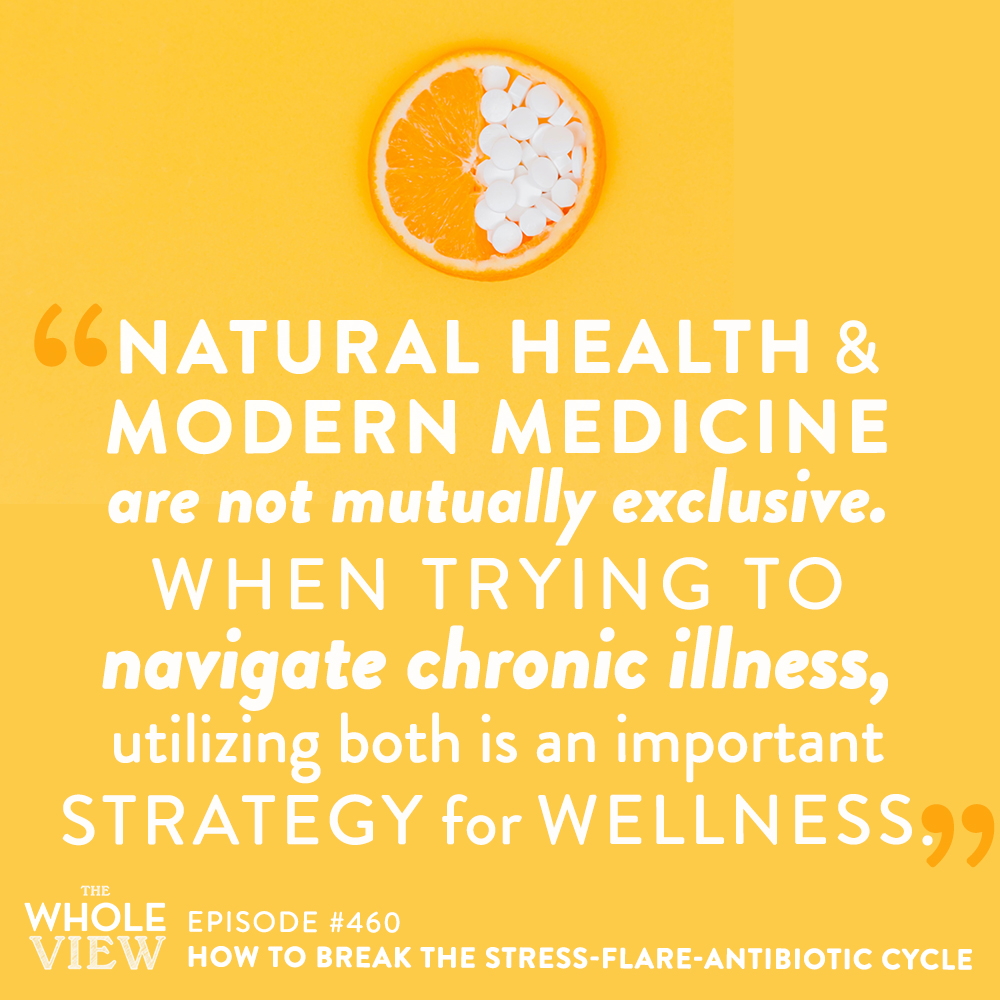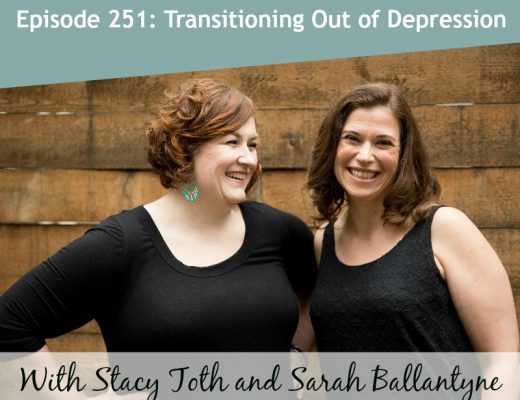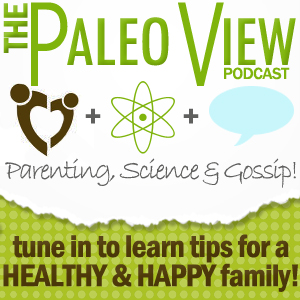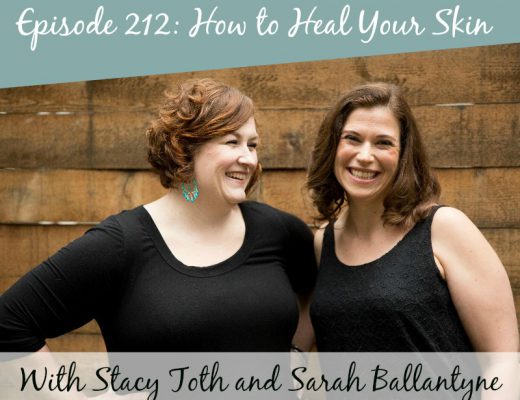
Welcome to episode 460 of The Whole View! This week, Sarah and Stacy look at the science behind antibiotics’ impact on the gut microbiome and what we can do to break the Stress-Flare-Antibiotic Cycle as much as possible. Stacy gives insight into actions you can take outside the body, while Sarah dives deep into foods and lifestyle habits that can help from within.
If you enjoy the show, please review it on iTunes!
The Whole View, Episode 460: How to Break the Stress-Flare-Antibiotic Cycle
Welcome back to episode 460! (0:28)
This week’s episode was inspired by a lister question. As always, Stacy and Sarah pick questions that really resonate with the:
First off, my mother and I love your show and have been listening to the show for years. I love how you can tackle complicated topics and boil them down to easy to understand and enjoyable shows. Stacy, your journey with your son through ADHD was such a help for me when my oldest son was diagnosed. It gave me a place to go when I wasn’t sure where to go next. Now to the reason I’m writing to you.
I have been battling rosacea flares ever since 2010 when I had my first son. Pregnancy seemed to set everything off and I now deal with flares off and on. I know stress is a trigger. My dermatologist’s answer is always to put me on antibiotics for months at a time and it’s killing my gut health.
I had finally gotten my gut health to a pretty good place and hadn’t needed to be treated for quite some time and then Covid hit, my mother-in-law moved in, and I started remote schooling 3 extra kids in my home along with my own children. No stress here! My question is, how do I maintain my gut health when I have Rosacea and have to use antibiotics to control the flare? Thank you for all the hard work you ladies put into your shows!
-Sara
Sometimes, the flare itself can be additional stress and can snowball the problem.
Lifestyle changes aren’t going to solve the issue independently, but adding different choices in where you can certainly help manage symptoms.
First, Medication Isn’t Failure!
In some situations, antibiotics are absolutely needed. (7:09)
It’s definitely smart to avoid antibiotics when they aren’t really necessary (like viral flu and colds). But when it comes to certain illnesses and infections (the ones used to wipe out huge chunks of the human population!), antibiotics can prevent serious complications and even save our lives.
There’s no reason we should ever feel guilty or like we’ve “failed” just because we need to take antibiotics.
While following a healthy diet and lifestyle typically supports much stronger and well-regulated immune systems, it does not (sadly) make us invisible.
The necessity for antibiotics doesn’t mean that you didn’t “Paleo/AIP/Nutrivore hard enough,” so don’t be hard on yourself.
While it’s always a good idea to reflect on ways to improve the quality and consistency of our diet and lifestyle choices, what’s most important while recovering from illness is making science-based, informed choices that give us the best chance of getting healthy efficiently!
Preventative Skincare
Stacy refers listeners back to the episode on Dry Winter Skin because of the information on the moisture barrier in that show. (12:15)
She also recommends checking out Science of the Skin Barrier.
Beauty counter has a great Safe SPF Stacy loves! She cautions listeners to be wary of the ingredients in their products when shopping for sunscreen.
Studies have shown that many modern SPF on the market (chemical and mineral) have large amounts of Benzine contaminants, a known carcinogen.
There are prescription topical medications to help with issues such as Rosacea. That is another option to talk to your doctor about.
Another known thing to irritate Rosacea is using hot water and dairy consumption.
Sarah adds that red light therapy is another interesting avenue to look into to add to your preventative care.
Self Care and Stress vs. Sleep
Stress is a huge trigger for Sarah, and despite being proactive at preventing stress, it’s not 100%. (18:01)
Sarah and Stacy have talked about the stress, work-life balance, and stress-sleep cycle on quite a few recent shows:
- 458: Collective Trauma and Re-Entry Anxiety
- 447: Basic Needs Don’t Count as Self-Care
- 446: Nutrient Deficiencies Caused by Stress
- 409: Let’s Talk About Magnesium
- 397: Practical Tips for the Sleep Stress Cycle
- 351: Stress on Health
Sarah explains that her biggest obstacle is her perfectionist tendencies.
It’s critical to put self-care on our busy to-do lists! Self-care doesn’t have to mean a mani-pedi. It can be as easy as giving yourself time to do something you enjoy.
Resilience activities like going for a walk, meditating, or cuddling with a pet are great ways to give yourself some time away.
Stacy reminds listeners that they are allowed to let go and say no.
Focusing on sleep when we can’t control stress is another great way to help your body as much as possible.
Antibiotics vs. Gut Health
The word literally means “against life” from its Greek roots. (27:10)
Antibiotics stop or slow down the growth of microscopic organisms (bacteria, fungi, and some parasites), in turn, treating potentially dangerous infections.
Antibiotics can also destroy beneficial bacteria and yeast that mediate an incredible array of processes in our body. This can include gut barrier integrity, tuning the immune system, and increasing the bioavailability of nutrients from our food!
So, whenever we embark on antibiotic therapy, the goal should be to protect, preserve, and restore these beneficial organisms as soon as possible.
Antibiotics, by design, are very destructive to the gut microbiome, which is why so many gastrointestinal side effects are reported.
Taking Probiotics While on Antibiotics
It’s a myth that we should wait until we’ve finished a course of antibiotics before trying to rebuild our gut flora with probiotics. (29:52)
In reality, taking probiotics during antibiotic therapy is one of the most helpful things we can do to maintain gut health!
Even if the probiotics we ingest during antibiotic therapy don’t take up permanent residence yet, they can still help keep pathogens at bay and prevent crazy microflora imbalances.
Several studies have examined the effects of probiotics on antibiotic-induced side effects, and the results have been impressive!
Probiotics can go a long way to reduce unpleasant symptoms, especially gastrointestinal distress like diarrhea. This can occur when antibiotics wipe out the competitors for pathogenic bacteria and allow diarrhea-inducing strains to flourish.
One meta-analysis looked at 63 trials on probiotics to prevent antibiotic-associated diarrhea and found a major reduction in diarrhea when people took Lactobacillus-based probiotics.
Other meta-analyses found that Saccharomyces boulardii and Lactobacillus rhamnos, in particular, were very helpful for reducing antibiotic-associated diarrhea.
And, additional studies have found various probiotic strains (especially Lactobacillus) can help reduce nausea, taste disturbance, headaches, hypersensitivity, and other symptoms when taken during a round of antibiotics!
One study tested the effects of starting probiotics (Lactobacillus acidophilus and Bifidobacterium bifidum) after antibiotic therapy versus during antibiotic therapy.
The group that started taking probiotics while still on antibiotics had more stable microflora levels and less gut dysbiosis throughout the experiment!
Taking Action Against the Stress-Flare-Antibiotic Cycle
Sarah recommends loading up on fermented foods teeming with natural probiotics.
These include raw, unpasteurized sauerkraut, kimchi, fermented carrots, fermented beets, pickles, fermented fruits (chutneys, jams, pickled jackfruit, green papaya), kombucha, beet kvass, coconut milk kefir, coconut milk yogurt, and raw condiments.
For people who aren’t sensitive to dairy or soy, unpasteurized yogurt and kefir, natto, miso, tempeh, and tamari sauce are also great options.
For the best results, eat these foods 2 to 4 hours after an antibiotic dose.
Sarah also recommends taking probiotic supplements, especially if you’re yeast or histamine sensitive or otherwise don’t do well with fermented foods.
For preventing antibiotic-associated diarrhea and other side effects, an intake of at least 5 billion CFU/day for children or 10 billion CFU/day per adult is recommended.
Several existing trials show that Lactobacilli, Bifidobacteria, and Saccharomyces boulardii are the most effective types for reducing antibiotic side effects.
All probiotics should be consumed with food, and bacterial strains should be taken at least 2 to 4 hours after each antibiotic dose so that they don’t get inhibited by the antibiotic itself.
Saccharomyces boulardii is actually a form of probiotic yeast, making it particularly useful while taking bacteria-killing antibiotics.
Don’t forget to consume plenty of gut barrier nutrients!
What to Do After Taking Antibiotics
Stacy adds that reintroducing known trigger foods should only happen when your flare is over to prevent the stress-flare-antibotic cycle. (39:02)
Once we’ve completed antibiotic therapy, it’s time to seriously buckle down and get our gut microbiome back in shape.
Chances are, the antibiotics caused a major loss in microbial diversity, wiped out many beneficial species, and may have allowed pathogenic strains to flourish.
So, the goal is to rebalance the microbiome and restore as much (good) diversity as possible!
There’s a really immense amount of information in The Gut Health Guidebook, but it all boils down to 20 keys to gut health.
A healthy gut microbiome eats a nutrient-dense and varied diet that is moderate-fat and moderate-carb to best support a healthy gut microbiome. That includes plenty of veggies, fruit, mushrooms, and seafood, rounded out with nuts, seeds, grass-fed meats, fermented foods, and phytochemical-rich foods like herbs, tea, coffee, cacao extra virgin olive oil.
- 437: Intro To Nutrivore
- 424: 30 Fruits and Vegetables a Week?!
- 373: How Many Vegetables (Part 4) Powdered Veggies
- 304: What’s Better: Raw or Cooked Vegetables?
- 335: How Many Vegetables Part 3: Souping vs Smoothies
- 281: How Many Vegetables?!
- 413: The Gut Health Benefits of Nuts
- 415: Fish oil, Healthy or not?
- 414: Best Cooking Fats for Gut Health
Lifestyle Choices that Help Fight the Stress-Flare-Antibiotic Cycle
Be sure you’re hydrating without alkaline water.
Lifestyle factors are also essential, like getting enough sleep on a consistent schedule, entrenching a solid circadian rhythm, eating distinct meals instead of grazing, fasting overnight (12-14 hours, not IFing), living an active lifestyle managing stress.
It’s also super important to optimize vitamin D levels. For more info, see Episode 354: Everything Vitamin D.
A handful of traditionally excluded foods on the Paleo diet is a boon to our gut microbiomes. This includes A2 dairy like goat, sheep, or camel), most legumes (not soy or peanuts), pseudo-grains, corn, rice, and gluten-free oats.
However, none of these latter foods are fundamental for a healthy gut microbiome in the same way that mushrooms, seafood, and individual families of vegetables and fruit are.
Continue eating plenty of raw, unpasteurized, fermented foods throughout the day. These typically contain a huge spectrum of probiotic species and offer greater microbial diversity than most probiotic supplements.
Lacto-fermented fruits, vegetables, and beverages tend to be high in Lactobacillus and Bifidobacteria, while kefir and kombucha are great sources of Saccharomyces boulardii.
Eat from as many fermented foods as possible to get a variety of awesome microbes, both bacterial and yeast!
For more information, see Episode 329: The Link Between Carb Intolerance & Gut Health and Episode 457: The Problem with a Low-FODMAP Diet.
Studies have shown that SBOs like Just Thrive helps Lactobacillus grow and can help restore the gut microbiome after antibiotics.
Just Thrive is not sponsoring this episode, but you can still use TWV link for discounts on their products and get 15% off with the code THEWHOLEVIEW at checkout!
Stacy and Sarah recommend two probiotics from Smidge: Yeastbiotic and Probiotic.
Final Thoughts
The most important thing to do when managing the stress-flare-antibiotic cycle is to give your body what it needs to perform optimally. (50:50)
This is also why modern diet-culture is such an issue. Our goal is health, and when we focus on it, we see a lot of the claims made by diet culture aren’t scientifically supported to optimize health.
The idea of weight loss is often enough to justify choices that make us feel sluggish or sick, and it takes rerouting our mindset toward health to see through it.
There’s no one-size-fits-all recipe for feeling good. It’s about listening to your body and finding out what makes you feel your best. It’s not about how much you weigh.
Stacy reminds listeners interested in Beautycounter safer skincare to use the code CLEANFORALL20 for 20% off their purchase.
Be sure to hop over to Patreon for Stacy and Sarah’s unfiltered thoughts for more on this topic. Your subscription helps support this podcast and gets you front-line access to the Whole View.
Thanks for listening and we will see you next week!

Want more info on our Real Life? Never miss a post with our Real Everything newsletter (and get our best selling book, Eat Like a Dinosaur, as a welcome gift). Join here
Wanna be Healthy Inside & Out? Get educational info and exclusive sales with our non-toxic living newsletter (and get free samples as a thank you for joining our safer skincare community). Join here




